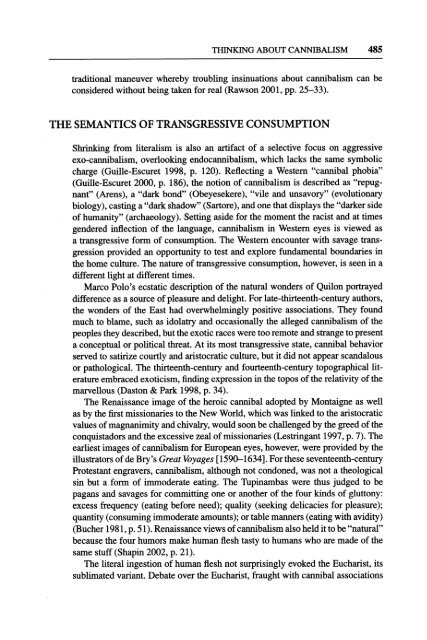Thinking about Cannibalism.pdf - Lucina Birth Services
Thinking about Cannibalism.pdf - Lucina Birth Services
Thinking about Cannibalism.pdf - Lucina Birth Services
You also want an ePaper? Increase the reach of your titles
YUMPU automatically turns print PDFs into web optimized ePapers that Google loves.
THINKING ABOUT CANNIBALISM 485<br />
traditional maneuver whereby troubling insinuations <strong>about</strong> cannibalism can be<br />
considered without being taken for real (Rawson 2001, pp. 25-33).<br />
THE SEMANTICS OF TRANSGRESSIVE CONSUMPTION<br />
Shrinking from literalism is also an artifact of a selective focus on aggressive<br />
exo-cannibalism, overlooking endocannibalism, which lacks the same symbolic<br />
charge (Guille-Escuret 1998, p. 120). Reflecting<br />
a Western "cannibal phobia"<br />
(Guille-Escuret 2000, p. 186), the notion of cannibalism is described as "repug<br />
nant" (Arens), a "dark bond" (Obeyesekere), "vile and unsavory" (evolutionary<br />
biology), casting<br />
a "dark shadow" (Sartore), and one that displays the "darker side<br />
of humanity" (archaeology). Setting aside for the moment the racist and at times<br />
gendered inflection of the language, cannibalism in Western eyes is viewed as<br />
a transgressive form of consumption. The Western encounter with savage trans<br />
gression provided<br />
an opportunity<br />
to test and explore fundamental boundaries in<br />
the home culture. The nature of transgressive consumption, however, is seen in a<br />
different light at different times.<br />
Marco Polo's ecstatic description of the natural wonders of Quilon portrayed<br />
difference as a source of pleasure and delight. For late-thirteenth-century authors,<br />
the wonders of the East had overwhelmingly positive associations. They found<br />
much to blame, such as idolatry and occasionally the alleged cannibalism of the<br />
peoples they described, but the exotic races were too remote and strange to present<br />
a conceptual<br />
or political threat. At its most transgressive state, cannibal behavior<br />
served to satirize courtly and aristocratic culture, but it did not appear scandalous<br />
or pathological. The thirteenth-century and fourteenth-century topographical lit<br />
erature embraced exoticism, finding expression in the topos of the relativity of the<br />
marvellous (Daston & Park 1998, p. 34).<br />
The Renaissance image of the heroic cannibal adopted by Montaigne<br />
as well<br />
as by the first missionaries to the New World, which was linked to the aristocratic<br />
values of magnanimity and chivalry, would soon be challenged by the greed of the<br />
conquistadors and the excessive zeal of missionaries (Lestringant 1997, p. 7). The<br />
earliest images of cannibalism for European eyes, however, were provided by the<br />
illustrators of de Bry's Great Voyages [1590-1634]. For these seventeenth-century<br />
Protestant engravers, cannibalism, although not condoned, was not a theological<br />
sin but a form of immoderate eating. The Tupinambas<br />
were thus judged to be<br />
pagans and savages for committing<br />
one or another of the four kinds of gluttony:<br />
excess frequency (eating before need); quality (seeking delicacies for pleasure);<br />
quantity (consuming immoderate amounts); or table manners (eating with avidity)<br />
(B?cher 1981, p. 51). Renaissance views of cannibalism also held it to be "natural"<br />
because the four humors make human flesh tasty to humans who are made of the<br />
same stuff (Shapin 2002, p. 21).<br />
The literal ingestion of human flesh not surprisingly evoked the Eucharist, its<br />
sublimated variant. Debate over the Eucharist, fraught with cannibal associations


